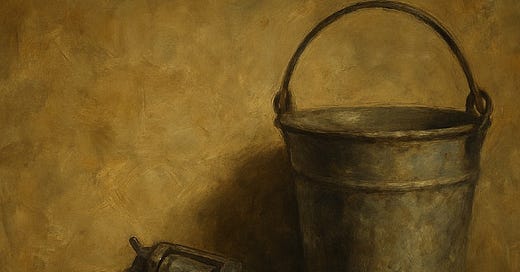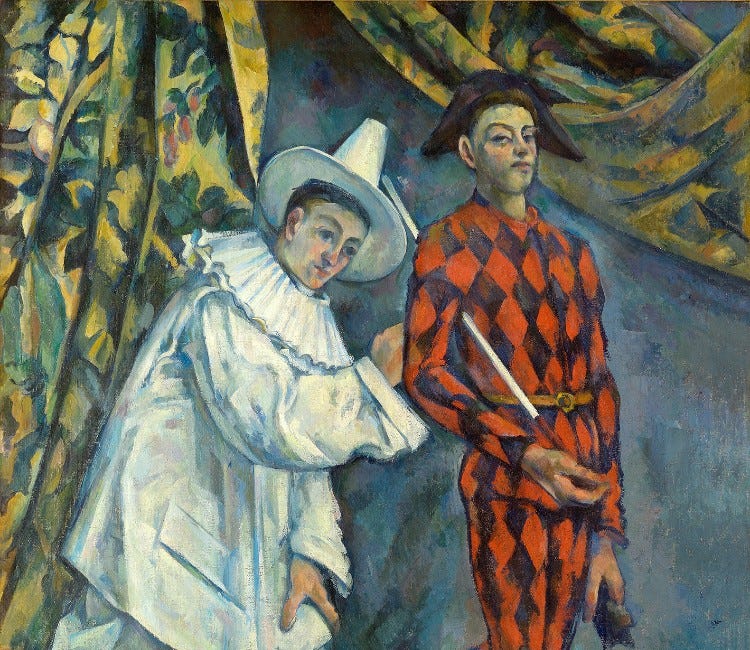Komedy Klass: Heightening and Chekhov's Bucket of Cum
If a bucket of ejaculate is placed on a shelf in the first act...
***This is the third installment of IMBW Komedy Klass! You can always send your stuff to KomedyKlass@imightbewrong.org — every time we do this, I pick one piece to serve as a focal point.
Anton Chekhov once said “If in the first act, you have hung a pistol on the wall, then in the following one, it should be fired. And you have to listen to me, because I’m Chekhov. I wrote War and Peace…didn’t I? Or am I the Crime and Punishment guy? I’m definitely one of those Russian writer guys that people who like books are super horny for, so when I give writing advice, you should listen.”
But what if Chekhov had been a comedian instead of a writer of plays that you read four pages of in college? His principle that every element in a piece of writing should have a purpose would still hold, but it would take a different form. It would be more focused on making sure that the funny thing in a sketch, once introduced, gets increasingly ridiculous so that the joke stays fresh. This is what comedians call “heightening”, and it might be the single most important principle in comedy writing.
Today’s reader-submitted funny thing comes from Greg Hudson of the sketch troupe Ghost Girl. The sketch was written by Jacob Stone and performed at New York’s Magnet Theatre. Fair warning: The sketch is extremely not safe for work, unless you happen to work in a 1970s porno theatre or a burlesque house in Thailand. Importantly, though, the sketch is an excellent illustration of heightening.
This sketch plays with two tropes of crime dramas: 1) Detectives with unique sensory powers, and 2) Semen analysis. There is a ton of semen analysis on shows like Law and Order and CSI: Whatever, so much that it seems like you can maybe get away with any crime so long as you don’t ejaculate while doing it. At any rate: The premise is clear, the audience buys in, and the joke is established within the first 40 seconds. But 40 seconds isn’t a sketch, and that’s where heightening comes in.
Heightening is the process of presenting a joke in increasingly outrageous ways. The way it’s supposed to work is: You tell a joke, get a laugh, tell a more outrageous version of the joke, get another laugh, and then you tell the most outrageous version of the joke possible and end the scene before people realize that you just told the same joke three times. Phrased another way: The second you introduce a character named John Taster who solves murders by tasting clues, it’s pretty much a fait accompli that he’ll drink a bucket of cum and have the killer ejaculate on his face. Those are just the rules of the comedy universe.
Not every example of heightening involves drinking a bucket of sperm (though a shocking amount do). Here are some famous sketches where the heightening is especially clear:
In the Dana Carvey/Robert Smigel Gerald Ford sketch, the whole joke is Gerald Ford dying in increasingly strange ways. You don’t start with “Gerald Ford mauled by a circus lion in a convenient store” — you start with him jumping out of a window and then heighten from there.
In the SNL “take your shirt off” sketch, the heightening can be measured by the ridiculousness of the prosthetics. Kevin Nealon is very hairy — that’s kind of funny, so that goes first. Dana Carvey has a baboon heart beating outside of his body — that’s pretty outrageous, so that goes last.
In the Kids in the Hall “girl drink drunk” sketch, both the girl drinks and the consequences of those drinks keep getting more extreme.
In the Mr. Show “pre-taped call in show” sketch, the heightening comes from David Cross’ level of frustration.
In Steve Martin’s “Holiday Wish” monologue — which I wrote about last Christmas — the heightening comes through increasingly selfish wishes. The tricky thing there is figuring out which wish counts as more extreme than the other, but Martin (of course) gets it right by realizing that the funny thing isn’t the size of the wish, but the selfishness of the wish.
Basically: Heightening is the tool you use to turn a funny idea into a several-minutes-long sketch. A good writer will come up with twists and details that the audience doesn’t see coming. For example, I liked the sandwich beat in the Cum Taster sketch — they needed a twist, because the sketch can’t just be the detective drinking ever-larger quantities of cum.
A word of warning about heightening, though: An over-reliance on heightening can lead to sketches that are cookie-cutter and predictable. IMHO, the “take your shirt off” sketch (above) is playing a dangerous game, because we immediately realize that each guy is going to have some weird thing. The sketch works because each reveal is funny in its own right — “Mike Myers with prosthetic breasts” is money in the comedy bank. But if the reveals were less fun, the audience would think “okay, we get it — how many more of these are there?” The surest way for a sketch to bomb is to present several versions of a joke that the audience didn’t like the first time.
A sketch show that manages to heighten in ways that keeps things fresh is I Think You Should Leave. That show typically uses one or two simple heightens to establish the game before making everything insane. For example, the “ghost tour” sketch starts with a predictable (but funny) heighten — Tim’s character says increasingly dirty things. But they don’t do that for long before adding the element of Tim’s character being sincerely confused about what’s happening. Comedy audiences are probably more sophisticated than they used to be — we’ve seen the pattern of “funny thing, funny thing times two, funny thing times ten” for decades. I Think You Should Leave keeps things fresh by taking turns that are hard to predict, which is important, because you want your jokes to surprise the audience.
IMHO, the hardest part of comedy is coming up with a funny idea. Once you have an idea, you definitely want to milk it for all its worth. Heightening lets you get the most out of your idea by presenting it several different ways, and — if you do it right — you’ll surprise the audience each time. You want to get the maximum payoff possible from each idea, which won’t always result in a character shotgunning a bucket of cum, but — if you’re doing things right — it usually will.
Credits for the Detective Taster sketch: Written by Jacob Stone; Directed by Dennis Pacheco; Detective Taster: Greg Hudson; Police Chief: Roslyn Seale; Rookie Cop: Nick Phillips; Lieutenant: Nisarah Lewis; Killer: Nathan Blinn; Dead Body: Czach Dziadosz
Komedy Klass: What -- Or Better Yet WHY -- is Satire?
***This is the second edition of IMBW Komedy Klass! You can always send your stuff to KomedyKlass@imightbewrong.org — every time we do this, I pick one piece to serve as a focal point.







I’ll drink 🥛 to this! Thank you Jeff!! And thanks for my new watchlist.
“the sketch can’t just be the detective drinking ever-larger quantities of cum.”
This is where we disagree.